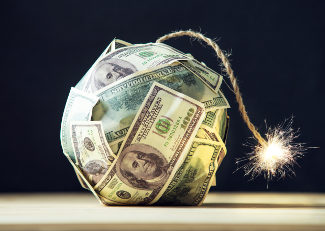Fed Expert: Break Up the Mega-Banks!
The old riddle, “Where does an eight-hundred-pound gorilla sit?” (Answer: “Anywhere it wants…”) applies more clearly to big banks in our modern economy than it does even to our primate friends. We’ve given them free rein to transform from lenders and custodians of our money to gamblers and speculators. Now their very size, and the degree of damage they can cause, means we have to let them do whatever they darn well please.
What’s more, we’re kidding ourselves if we think the Justice Department’s criminal charges and ten-billion-dollar fines slapped last year on JPMorgan, Citigroup, Barclays and Royal Bank of Scotland can even skin the bark off their money tree. Ask yourself whether a fifty-dollar traffic ticket yesterday has ever stopped you from speeding today.
Such banks have been labeled “too big to fail” because if they implode the fallout would be devastating across our whole economy. Thus taxpayers are forced to pick up the tab when their gambles don’t pay off. Heads the big banks win, tails they win.
Fed Chief Janet Yellen has espoused a guarded outlook on the issue. But not all of her colleagues share her middle-of-the-road point of view. In a recent speech in Washington, Minneapolis Federal Reserve President Neel Kashkari told his audience, “The biggest banks are still too big to fail and continue to pose a significant risk to our economy.”
The former Goldman Sachs Group, Inc. banker knows what he’s talking about. He helped shepherd the U.S. Treasury’s seven-hundred-billion-dollar Troubled Asset Relief Program (TARP) in the aftermath of the 2008 recession.
Kashkari suggests the government should tax behemoth banks on their leveraged transactions. That way the costs of huge loan defaults would be borne by the banks themselves instead of taxpayers. It would likely also deter at least some of the reckless practices that have led to defaults in the past. Nothing like being forced to pay the piper.
Kashkari also proposes breaking up banks – principally by separating them into entities which function as banks and those which function as investment houses or brokerages. Thus severed, taxpayers would no longer be liable for the failed speculative activity of banks’ investment divisions.
The Glass-Steagall Act of 1932 offered this kind of clean separation between the banking and investment activities of banks, but President Clinton authorized the repeal of that act in 1999. In 2010, President Obama signed into law the Dodd–Frank Wall Street Reform and Consumer Protection Act. This offered a few watered-down provisions from the repealed Glass-Steagall Act, but not enough to satisfy Kashkari and other reformers.
Since you and I are neither senators nor Wall Street reformers, there’s only so much we can do to keep banks from becoming too big to fail. But as long as we continue to trust them with our money, there’s at least one important thing we can do to protect ourselves: We can invest in gold.
When you own physical gold, even too-big-to-fail bank isn’t big enough to claim your coins as part of their bail-out agreement. Nor, when your banker puts on his stockbroker’s hat, can he bet the farm with your money. Nor can he use it to securitize your mortgage or auto loan.
As a tangible asset, your gold represents real, non-digital wealth. Even if all the banks in the United States merge, re-organize and/or fail, your gold, your hard-earned savings, will remain intact.


Leave a Reply